Drought Resistance Physiological Responses of Alfalfa to Alternate Partial Root-Zone Drying Irrigation
Abstract
1. Introduction
2. Materials and Methods
2.1. Experimental Design
2.2. Test Materials
2.3. Irrigation Treatment
2.4. Measurement Indicators and Methods
2.4.1. Growth Status of Alfalfa
2.4.2. Moisture Status of Alfalfa Leaves
2.4.3. Antioxidant Defense System of Alfalfa Leaves
2.4.4. Regulation of Osmotic Adjustment Capacity in Alfalfa Leaves
2.5. Data Processing and Statistical Methods
3. Results
3.1. Growth Status of Alfalfa Under Different Irrigation Methods and Irrigation Volume

3.2. Water Status of Alfalfa Leaves Under Different Irrigation Methods and Irrigation Volume
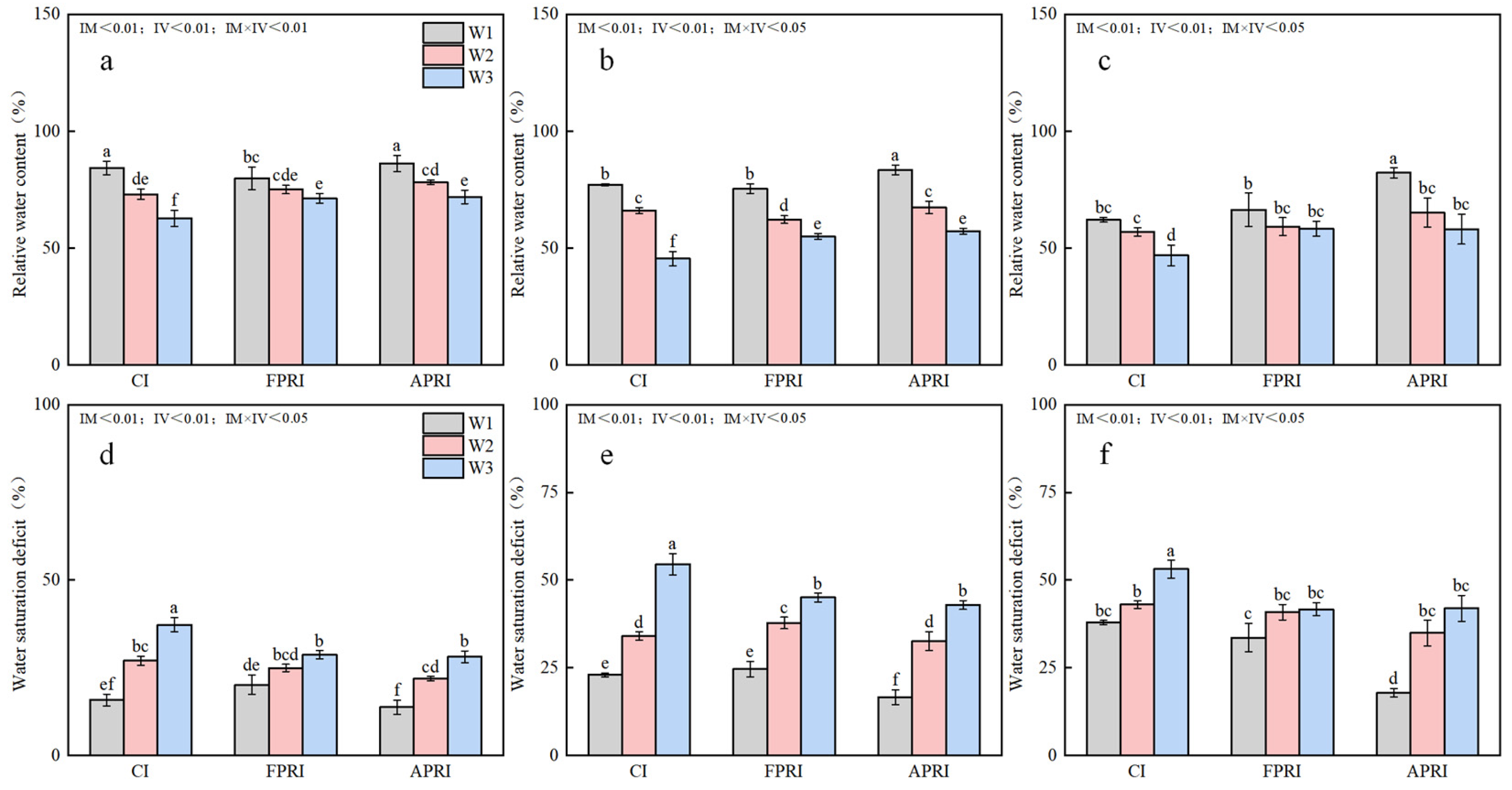



3.3. Antioxidant Enzyme Activity of Alfalfa Leaves Under Different Irrigation Methods and Irrigation Volume



3.4. The Osmotic Regulation Capacity of Alfalfa Leaves Under Different Irrigation Methods and Irrigation Volume




3.5. Correlation Analysis Between Various Indicators, Principal Component Analysis, and Polynomial Regression Fitting
4. Discussion
4.1. The Effect of APRI and Moisture Adjustment on the Growth Characteristics of Alfalfa
4.2. The Effect of APRI and Moisture Adjustment on the Water Status of Alfalfa Leaves
4.3. The Effect of APRI and Moisture Adjustment on the Antioxidant Defense System of Alfalfa Leaves
4.4. The Effect of APRI and Moisture Adjustment on the Osmotic Regulation Substances in Alfalfa Leaves
5. Conclusions
Author Contributions
Funding
Institutional Review Board Statement
Data Availability Statement
Acknowledgments
Conflicts of Interest
Abbreviations
| APRI | Alternate Partial Root-zone Drying Irrigation |
| FPRI | Fixed Partial Root-zone Drying Irrigation |
| CI | Conventional Irrigation |
| WHC | Water-Holding Capacity |
| RWC | Relative Water Content |
| ABA | Abscisic Acid |
| ROS | Reactive Oxygen Species |
| MDA | Malondialdehyde |
| SOD | Superoxide Dismutase |
| POD | Peroxidase |
| CAT | Catalase |
| Pro | Proline |
| SS | Soluble Sugars |
| SP | Soluble Protein |
References
- Mueller, N.D.; Gerber, J.S.; Johnston, M.; Ray, D.K.; Ramankutty, N.; Foley, J.A. Closing yield gaps through nutrient and water management. Nature 2012, 490, 254–257. [Google Scholar] [CrossRef] [PubMed]
- D’Odorico, P.; Davis, K.F.; Rosa, L.; Carr, J.A.; Chiarelli, D.; Dell’Angelo, J.; Gephart, J.; MacDonald, G.K.; Seekell, D.A.; Suweis, S.; et al. The global food-energy-water nexus. Rev. Geophys. 2018, 56, 456–531. [Google Scholar] [CrossRef]
- Lorenzo, R.; Chiarelli, D.D.; Rulli, M.C.; Dell’Angelo, J.; D’Odorico, P. Global agricultural economic water scarcity. Sci. Adv. 2020, 6, eaaz6031. [Google Scholar]
- Bouton, J.H. An overview of the role of lucerne (Medicago sativa L.) in pastoral agriculture. Crop Pasture Sci. 2012, 63, 734. [Google Scholar] [CrossRef]
- Zhao, Z.; Wang, P.; Chen, J.; Zhang, F. Economic spillover effect of grass-based livestock husbandry on agricultural production—A case study in Hulun Buir, China. Technol. Forecast. Soc. Chang. 2021, 168, 120752. [Google Scholar] [CrossRef]
- Nurkhaida, R.; Rejekiningrum, P. Trend analysis of agricultural water supply and demand for water conservation and climate change anticipation. IOP Conf. Ser. Earth Environ. Sci. 2021, 648, 012102. [Google Scholar] [CrossRef]
- Qin, J.; Ramírez, D.A.; Xie, K.; Li, W.; Yactayo, W.; Jin, L.; Quiroz, R. Is partial root-zone drying more appropriate than drip irrigation to save water in china? A preliminary comparative analysis for potato cultivation. Potato Res. 2018, 61, 391–406. [Google Scholar] [CrossRef]
- Grimes, D.W.; Walhood, V.T.; Dickens, W.L. Alternate-furrow irrigation for San Joaquin valley cotton. Calif. Agric. 1968, 22, 4–6. [Google Scholar]
- Fischbach, P.E.; Mulliner, H.R. Every-other furrow irrigation of corn. Trans. ASABE 1974, 17, 426–428. [Google Scholar] [CrossRef]
- Davies, W.J.; Wilkinson, S.; Loveys, B. Stomatal control by chemical signalling and the exploitation of this mechanism to increase water use effificiency in agriculture. New Phytol. 2002, 153, 449–460. [Google Scholar] [CrossRef]
- Davies, W.J.; Zhang, J.H. Root signals and the regulation of growth and development of plants in drying soil. Annu. Rev. Plant Physiol. Plant Mol. Biol. 1991, 42, 55–76. [Google Scholar] [CrossRef]
- Kang, S.Z.; Zhang, J.H. Controlled alternate partial root-zone irrigation: Its physiological consequences and impact on water use efficiency. J. Exp. Bot. 2004, 55, 2437–2446. [Google Scholar] [CrossRef] [PubMed]
- Gholinezhad, E.; Darvishzadeh, R.; Moghaddam, S.S.; Popović-Djordjević, J. Effect of mycorrhizal inoculation in reducing water stress in sesame (Sesamum indicum L.): The assessment of agrobiochemical traits and enzymatic antioxidant activity. Agric. Water Manag. 2020, 238, 106234. [Google Scholar] [CrossRef]
- Du, T.S.; Kang, S.Z.; Zhang, J.H.; Li, F.; Yan, B. Water use efficiency and fruit quality of table grape under alternate partial root-zone drip irrigation. Agric. Water Manag. 2008, 95, 659–668. [Google Scholar] [CrossRef]
- Liu, F.L.; Shahnazari, A.; Andersen, M.N.; Jacobsen, S.-E.; Jensen, C.R. Physiological responses of potato (Solanum tuberosum L.) to partial root-zone drying: ABA signalling, leaf gas exchange, and water use efficiency. J. Exp. Bot. 2006, 57, 3727–3735. [Google Scholar] [CrossRef]
- Raza, M.A.S.; Ahmad, S.; Saleem, M.F.; Khan, I.H.; Iqbal, R.; Zaheer, M.S.; Haider, I.; Ali, M. Physiological and biochemical assisted screening of wheat varieties under partial rhizosphere drying. Plant Physiol. Biochem. 2017, 116, 150–166. [Google Scholar] [CrossRef]
- Brunner, I.; Pannatier, E.G.; Frey, B.; Rigling, A.; Landolt, W.; Zimmermann, S.; Dobbertin, M. Morphological and physiological responses of scots pine fine roots to water supply in a dry climatic region in Switzerland. Tree Physiol. 2010, 29, 541–550. [Google Scholar] [CrossRef]
- Mclean, E.H.; Ludwig, M.; Grierson, P.F. Root hydraulic conductance and aquaporin abundance respond rapidly to partial root-zone drying events in a riparian Melaleuca species. New Phytol. 2011, 192, 664–675. [Google Scholar] [CrossRef]
- Beis, A.; Patakas, A. Differential physiological and biochemical responses to drought in grapevines subjected to partial root drying and deficit irrigation. Eur. J. Agron. 2015, 62, 90–97. [Google Scholar] [CrossRef]
- Sun, Q.; Zhang, S.; Peng, X.; Ge, X.; Wen, B.; Jiang, Z.; Wang, Y.; Zhang, B. Alternating Partial Root-Zone Subsurface Drip Irrigation Enhances the Productivity and Water Use Efficiency of Alfalfa by Improving Root Characteristics. Agronomy 2024, 14, 849. [Google Scholar] [CrossRef]
- Lugojan, C.; Ciulca, S. Evaluation of relative water content in winter wheat. J. Hortic. For. Biotechnol. 2011, 15, 173–177. [Google Scholar]
- Bournonville, C.F.; Díaz-Ricci, J.C. Quantitative determination of superoxide in plant leaves using a modified NBT staining method. Phytochem. Anal. 2011, 22, 268–271. [Google Scholar] [CrossRef] [PubMed]
- Meloni, D.A.; Oliva, M.A.; Martinez, C.A.; Cambraia, J. Photosynthesis and activity of superoxide dismutase, peroxidase and glutathione reductase in cotton under salt stress. Environ. Exp. Bot. 2003, 49, 69–76. [Google Scholar] [CrossRef]
- Long, M.; Xu, Y.; He, X.; Liao, Y. Antioxidant Enzymes Activities of Medicago sativa L. Seedl. Under Salt Stress 2012, 20, 83–87. [Google Scholar]
- Senthilkumar, M.; Amaresan, N.; Sankaranarayanan, A. Estimation of Malondialdehyde (MDA) by Thiobarbituric Acid (TBA) Assay. In Plant-Microbe Interactions; Springer Protocols Handbooks; Springer: New York, NY, USA, 2020; pp. 103–105. [Google Scholar]
- Abrahám, E.; Hourton-Cabassa, C.; Erdei, L.; Szabados, L. Methods for determination of proline in plants. Methods Mol. Biol. 2010, 639, 317–331. [Google Scholar]
- Qi, J. Study on Functional Differences of Regeneration-Related Genes in Alfalfa Varieties with Different Fall Dormancy Grades. Ph.D. Thesis, Shihezi University, Shihezi, China, 2023. [Google Scholar]
- Grintzalis, K.; Georgiou, C.D.; Schneider, Y.J. An accurate and sensitive Coomassie Brilliant Blue G-250-based assay for protein determination. Anal. Biochem. 2015, 480, 28–30. [Google Scholar] [CrossRef]
- Kassaye, K.T.; Yilma, W.A.; Fisha, M.H.; Haile, D.H.; Wu, W. Yield and water use efficiency of potato under alternate furrows and deficit irrigation. Int. J. Agron. 2020, 2020, 8869098. [Google Scholar] [CrossRef]
- Jia, D.Y.; Dai, X.L.; Xie, Y.L.; He, M. Alternate furrow irrigation improves grain yield and nitrogen use efficiency in winter wheat. Agric. Water Manag. 2021, 244, 106606. [Google Scholar] [CrossRef]
- Zhang, J.; Chen, Y.Y.; Liu, W.H.; Guo, Z.G. Effect of alternate partial root-zone drying (PRD) on soil nitrogen availability to alfalfa. Agric. Water Manag. 2021, 258, 107167. [Google Scholar] [CrossRef]
- Wang, Y.; Liu, C.; Cui, P.; Su, D. Effects of partial root-zone drying on alfalfa growth, yield and quality under subsurface drip irrigation. Agric. Water Manag. 2021, 245, 106608. [Google Scholar] [CrossRef]
- Al-Kayssi, A.A. Role of alternate and fixed partial root-zone drying on water use efficiency and growth of maize (Zea mays L.) in gypsiferous soils. Int. Soil Water Conserv. Res. 2023, 11, 145–158. [Google Scholar] [CrossRef]
- Møller, I.M.; Jensen, P.E.; Hansson, A. Oxidative modifications to cellular components in plants. Annu. Rev. Plant Biol. 2007, 58, 459–481. [Google Scholar] [CrossRef] [PubMed]
- Zhou, D.H.; Li, T.; Yang, Y.L.; Qu, Z.; Ouyang, L.; Jiang, Z.; Lin, X.; Zhu, C.; Peng, L.; Fu, J.; et al. OsPLS4 is involved in cuticular wax biosynthesis and affects leaf senescence in rice. Front. Plant Sci. 2020, 11, 782. [Google Scholar] [CrossRef]
- Maulana, F.; Ayalew, H.; Anderson, J.D.; Kumssa, T.T.; Huang, W.; Ma, X.-F. Genome-wide association mapping of seedling heat tolerance in winter wheat. Front. Plant Sci. 2018, 9, 1272. [Google Scholar] [CrossRef]
- Qi, D.L.; Li, X.; Pan, C.; Li, J.; Xu, Y.; Zhu, J. Effect of nitrogen supply methods on the gas exchange, antioxidant enzymatic activities, and osmoregulation of maize (Zea mays L.) under alternate partial root-zone irrigation. J. Soil Sci. Plant Nutr. 2021, 21, 2083–2095. [Google Scholar] [CrossRef]
- Qin, F.F.; Xu, H.-L.; Xu, Q.C.; Wang, R. Applications of xerophytophysiology in plant production: Partial root drying improves tomato crops. J. Food Agric. Environ. 2009, 7, 981–988. [Google Scholar]
- Das, K.; Roychoudhury, A. Reactive oxygen species (ROS) and response of antioxidants as ROS-scavengers during environmental stress in plants. Front. Environ. Sci. 2014, 2, 53. [Google Scholar] [CrossRef]
- Wang, W.B.; Kim, Y.H.; Lee, H.S.; Kim, K.Y.; Deng, X.P.; Kwak, S.S. Analysis of antioxidant enzyme activity during germination of alfalfa under salt and drought stresses. Plant Physiol. Biochem. 2009, 47, 570–577. [Google Scholar] [CrossRef]
- Su, F.F.; Li, Y.; Liu, S.W.; Nie, S.; Xu, Q.; Qin, F.; Li, F.; Lyu, D.; Xu, H.L. Application of xerophytophysiology and signal transduction in plant production: Partial root-zone drying in potato crops. Potato Res. 2020, 63, 41–56. [Google Scholar] [CrossRef]
- Hu, T.T.; Yuan, L.N.; Wang, J.F.; Kang, S.; Li, F. Antioxidation responses of maize roots and leaves to partial root-zone irrigation. Agric. Water Manag. 2010, 98, 164–171. [Google Scholar] [CrossRef]
- Abboud, S.; Vives-peris, V.; Dbara, S.; Gómez-Cadenas, A.; Pérez-Clemente, R.M.; Abidi, W.; Braham, M. Water status, biochemical and hormonal changes involved in the response of Olea europaea L. to water deficit induced by partial root-zone drying irrigation (PRD). Sci. Hortic. 2021, 276, 109737. [Google Scholar] [CrossRef]
- Farooq, M.; Wahid, A.; Kobayashi, N.; Fujita, D.; Basra, S.M.A. Plant drought stress: Effects, mechanisms and management. Agron. Sustain. Dev. 2009, 29, 185–212. [Google Scholar] [CrossRef]
- Khan, S.U.; Bano, A.; Dinand, J.U.; Gurmani, A.R. Abscisic acid and salicylic acid seed treatment as potent inducer of drought tolerance in wheat (Triticum aestivum L.). Pak. J. Bot. 2012, 44, 43–49. [Google Scholar]
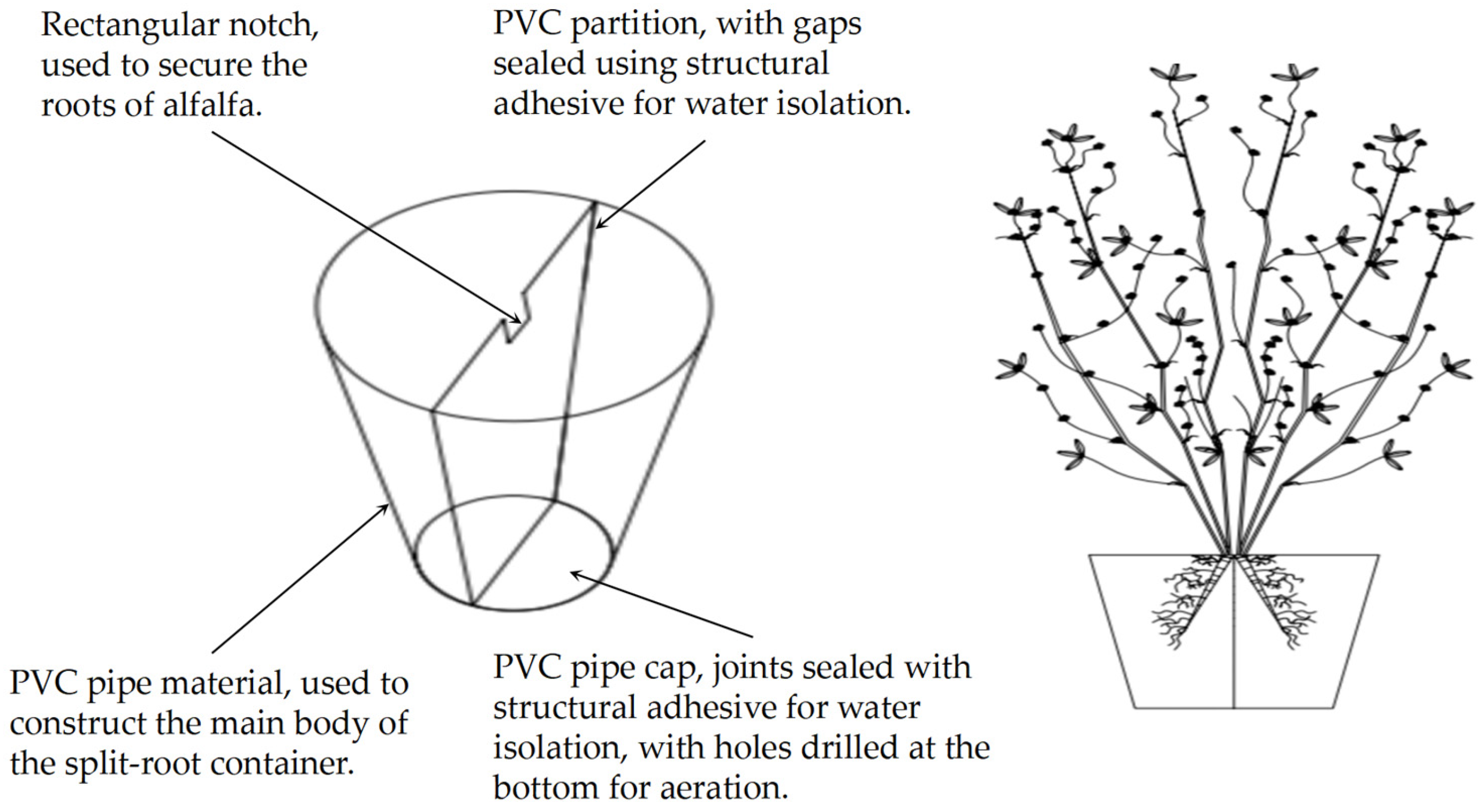
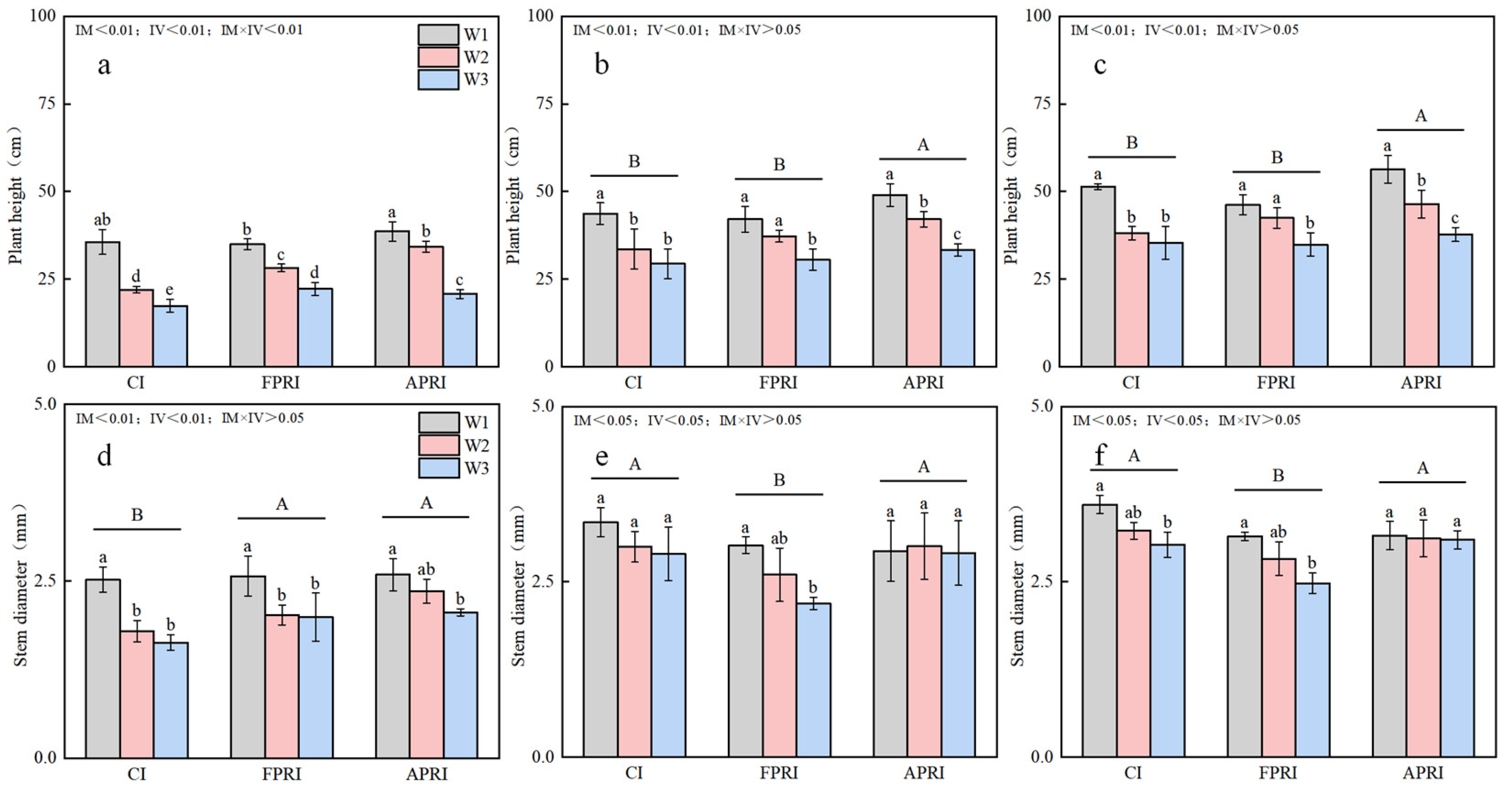

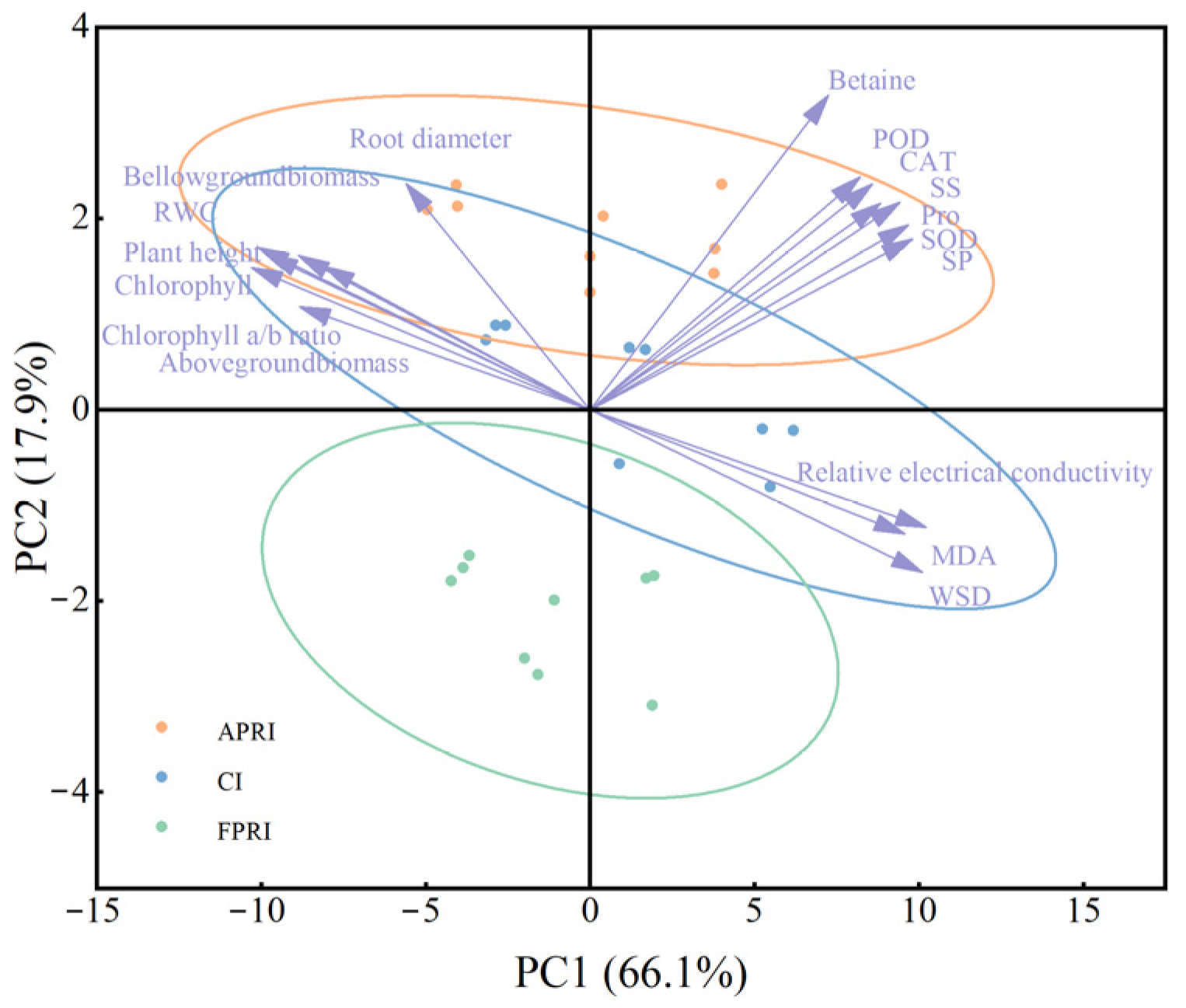
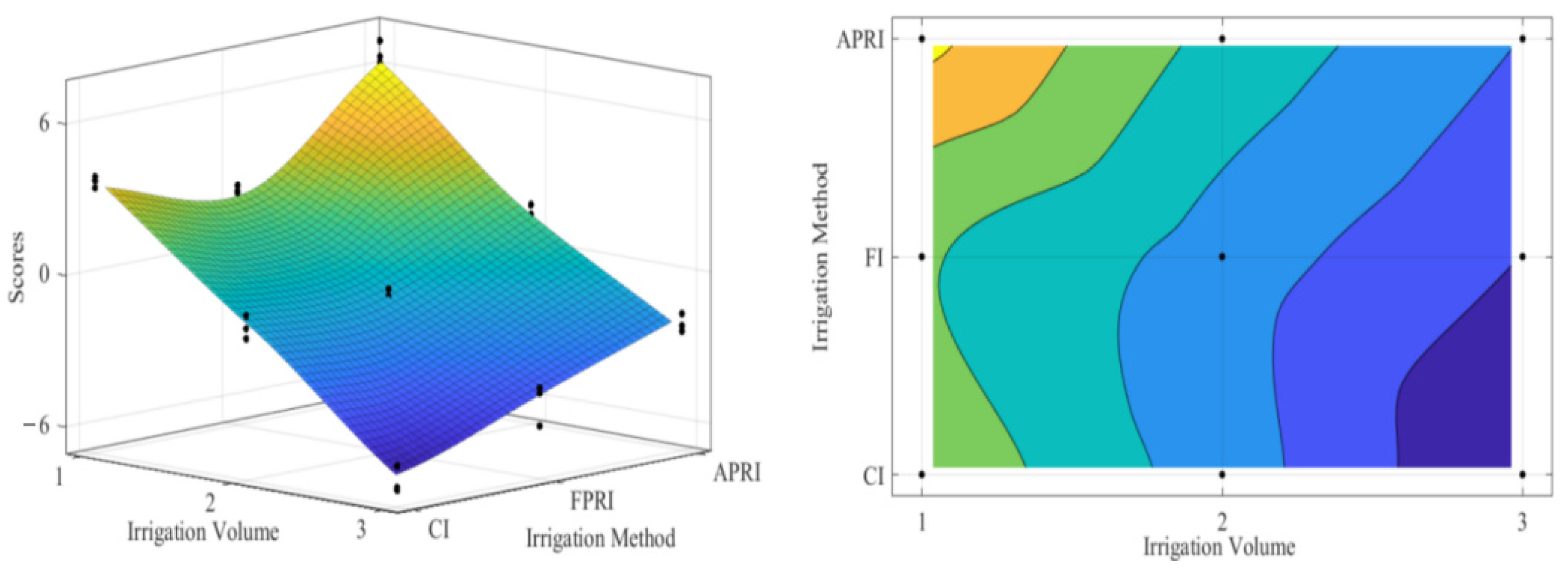
| Treatments | Water Supply Area | Irrigation Upper Limit |
|---|---|---|
| CI1 | Bilateral | 90% WHC |
| CI2 | Bilateral | 70% WHC |
| CI3 | Bilateral | 50% WHC |
| FPRI1 | Unilateral | 90% WHC |
| FPRI2 | Unilateral | 70% WHC |
| FPRI3 | Unilateral | 50% WHC |
| APRI1 | Bilateral alternation | 90% WHC |
| APRI2 | Bilateral alternation | 70% WHC |
| APRI3 | Bilateral alternation | 50% WHC |
Disclaimer/Publisher’s Note: The statements, opinions and data contained in all publications are solely those of the individual author(s) and contributor(s) and not of MDPI and/or the editor(s). MDPI and/or the editor(s) disclaim responsibility for any injury to people or property resulting from any ideas, methods, instructions or products referred to in the content. |
© 2025 by the authors. Licensee MDPI, Basel, Switzerland. This article is an open access article distributed under the terms and conditions of the Creative Commons Attribution (CC BY) license (https://creativecommons.org/licenses/by/4.0/).
Share and Cite
Sun, Q.; Wang, Y.; Zhang, S.; Peng, X.; Ge, X.; Wen, B.; An, Y.; Jin, G.; Zhang, Y. Drought Resistance Physiological Responses of Alfalfa to Alternate Partial Root-Zone Drying Irrigation. Agriculture 2025, 15, 1446. https://doi.org/10.3390/agriculture15131446
Sun Q, Wang Y, Zhang S, Peng X, Ge X, Wen B, An Y, Jin G, Zhang Y. Drought Resistance Physiological Responses of Alfalfa to Alternate Partial Root-Zone Drying Irrigation. Agriculture. 2025; 15(13):1446. https://doi.org/10.3390/agriculture15131446
Chicago/Turabian StyleSun, Qunce, Ying Wang, Shuzhen Zhang, Xianwei Peng, Xingyu Ge, Binghan Wen, Youping An, Guili Jin, and Yingjun Zhang. 2025. "Drought Resistance Physiological Responses of Alfalfa to Alternate Partial Root-Zone Drying Irrigation" Agriculture 15, no. 13: 1446. https://doi.org/10.3390/agriculture15131446
APA StyleSun, Q., Wang, Y., Zhang, S., Peng, X., Ge, X., Wen, B., An, Y., Jin, G., & Zhang, Y. (2025). Drought Resistance Physiological Responses of Alfalfa to Alternate Partial Root-Zone Drying Irrigation. Agriculture, 15(13), 1446. https://doi.org/10.3390/agriculture15131446





